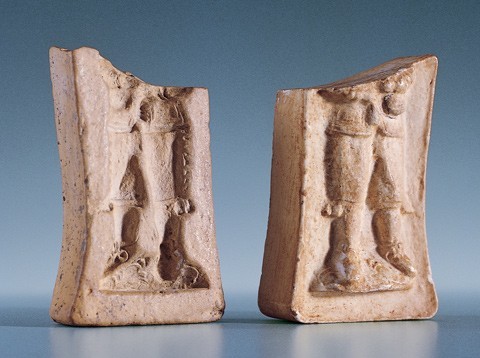
Fragment of a two-part intaglio mold and an impression of a toy soldier found at Jamestown, Virginia. Left: Mold, English, 1650–1700. Composition. H. 1.6". Right: Impression, Harpers Ferry, West Virginia, 1976. Dental plaster. (Courtesy, Colonial National Historical Park, COLO J 7084 and COLO J 30409; photo, Gavin Ashworth.) After cutting away the excess clay, a complete mold would have shaped a tiny figure in three dimension.
Among the more practical accoutrement for shaping a new nation—from mousetraps to weapons—an unexpected rediscovery on Jamestown Island reminds us of history’s more playful side. Fitted tightly in a drawer of miscellaneous metals, the buff-colored mold for making toy soldiers was hard to miss.
In the 1950s, National Park Service (NPS) archaeologists recovered the tiny form in Jamestown, Virginia’s “New Town” from a mid- to late-seventeenth-century trash pit “containing large quantities of goodies”—an apt characterization for this rare find. In fact, historical documentation of the island’s playthings is sparse.[1] The passage of time takes its toll on transient materials; frequently, however, the distinction between adult diversions and children’s toys is simply a difficult call.[2] Made of a durable composition, an amalgam of materials like plaster of Paris, sawdust, bran, and glue, the mold is neither altogether fragile nor its intent ambiguous.
Toy soldiers have been found in the ancient tombs of pharoahs and emperors and, most likely, anywhere else sticks, stones, and bits of cloth could be assembled. Thousands of years later children still played soldier, but perhaps waged war with an army of clay. Diminutive wares made from two-part molds, such as toy soldiers and figurines of people and animals, were popular in the seventeenth century. Recovered examples are often made from the same fine-grained and malleable white ball clay that was used to manufacture smoking pipes, an important seventeenth-century industry in England and Holland.
By 1625 artisans in the Virginia colony and upper reaches of the Chesapeake, having adapted to the local clays, were also skillfully turning out tobacco pipes. Since the fashionable introduction of smoking and the commercialization of tobacco, pipe making had become a successful enterprise in both the Old World and the New. And the New World, with its growing population and economy, had become an attractive new market for a secondary product. Probably a broken reject from a pipe maker’s kit, the mold from Jamestown suggests that toy figurine production—or at least the required tools—had reached America by the second half of the seventeenth century.
Although only a little more than twenty-five percent intact, the mold’s negative revealed “the lower half of the soldier (two legs and portion of body as high as the stomach) in intaglio.”[4] Almost a quarter of a century after its retrieval, intellectual curiosity got the better of Jamestown’s curatorial staff; the fragment was forwarded to the NPS museum laboratory at Harpers Ferry, West Virginia, literally, to fill in the gaps. Dental plaster was employed to produce the positive, accentuating beribboned breeches, lace-up shoes, a simple coat, and a leather pouch strapped securely around the waist. The left hand grasps what appears to be the grip of a regimental flag. Imagination, and a little research, would have to outfit the rest. A breastplate and helmet might have finished off this soldier’s garb, creating a more military look and a figure about two inches tall (fig. 1).
The Greek philosopher Plato believed that “you can discover more about a person in an hour of play than in a year of conversation.” The same could be said about a nation and its playthings. Perhaps it is fitting that this nation, so much at war—nearly three million killed or wounded in military action since America’s declaration of independence—should point to toy soldiers as one of the country’s earliest amusements. At least, says one modern-day sage, “in the world of toys, blood is never spilled, the odds are never too high, and the good guys will always win.”[5]
L. Madison Washburn
Freelance Writer
Assistant Curator, James River Institute for Archaeology
<Wren946@cs.com>
Colonial National Historical Park (CNHP) fieldnotes, Project 102, Structure 17, Refuse Pit 2 (p. 21).
Personal communication, 2002, Beverly Straube, Curator, Jamestown Rediscovery.™
Ivor Noël Hume, A Guide to Artifacts of Colonial America (New York: Alfred A Knopf, 1969), p. 314.
John L. Cotter, Chief Archeologist, CNHP (1950–1953), catalog card number COLO J 7084.
http://toycollecting.about.com/library/weekly/aa011800a.htm.
